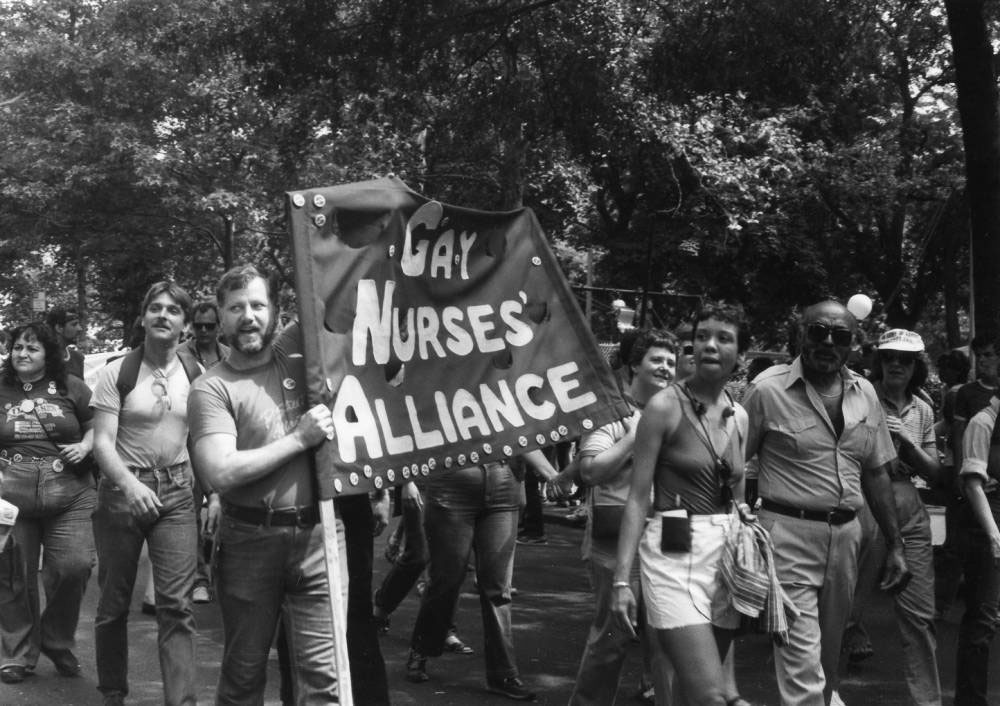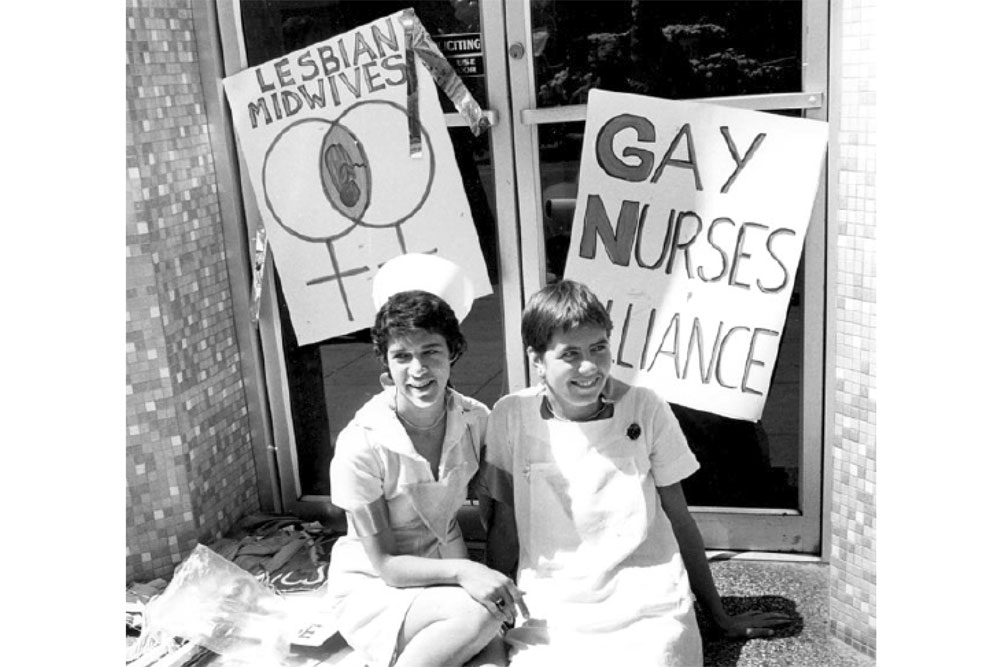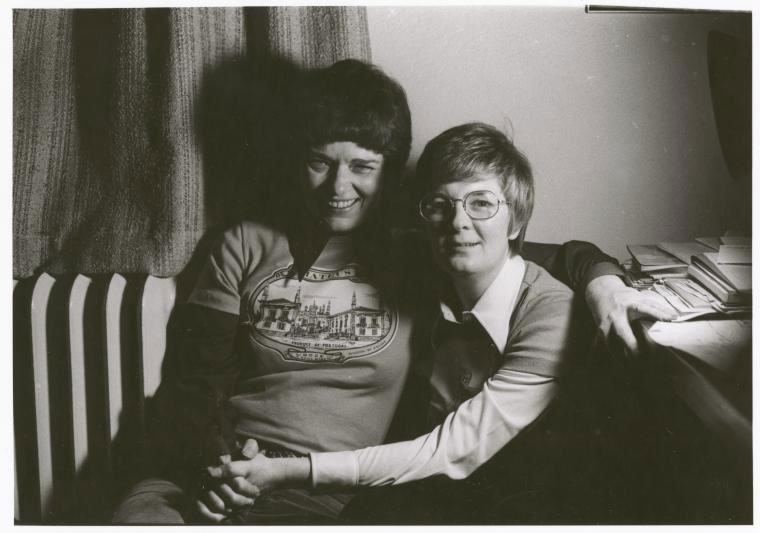Flashback Friday - When Gay Nurses Organized for Change

No one was quite prepared for the crowds that June day in 1974. The American Nurses Association was holding its annual convention at San Francisco’s Civic Center, but a newly formed outside group stole the show.
The Gay Nurses Alliance (GNA), founded 10 months earlier by two registered nurses, E. Carolyn Innes and G. David Waldron, had some consciousness-raising to do. “Our jobs are not secure,” Innes told the over-capacity audience of a thousand people. “A gay nurse who ‘comes out’ or is ‘discovered’ may shortly find herself or himself unemployed. Loss of license to practice nursing is also a real threat.”
Their symposium, “Gay People/Straight Health Care,” featured an audio-visual presentation depicting the problems gay people encountered. This was news for the mainstream audience: a gay man unable to visit his lover in intensive care because the hospital does not recognize homosexual relationships; a nurse afraid to challenge anti-gay jokes made by colleagues; and a patient whose dressings are neglected by homophobic hospital staff after a visit from his lover.
The GNA became the first national organization for gay, lesbian, and bisexual nurses when it launched in 1973 in Philadelphia, with fewer than a dozen members. Its goal was to make the healthcare system safe and responsive for gay people—staff and patients alike. That same year, homosexuality was officially struck from the American Psychiatric Association’s roster of mental illnesses.
“Nurses are the backbone of the health-care system . . . unless and until they are educated and sensitized about gay health care issues, gay people will continue to encounter problems and poor attitudes, if not outright hostility in the health care system."
John C. Lawrence, RN, president of the Gay Nurses Alliance
For many, this advocacy group was “a beacon of hope,” wrote Howard J. Brown, MD, in a 1974 letter to the American Journal of Nursing. ”Most gay people worry about being given equal treatment if they are hospitalized and somehow their sexual preference becomes known. I know these fears, for I have had them each time I was hospitalized.”
The GNA soon sprouted chapters in 17 states and Canada, with bi-coastal headquarters in Boston and San Diego. Membership was open to all nurses. Its newsletter, Signal, covered civil rights efforts and legislation, essays on well-being, and scientific findings. In 1982, it carried articles about Kaposi’s Sarcoma before the medical community identified the disease as AIDS.
In addition to providing a forum and support system for gay nurses, the GNA sought to educate the health-care community about gay lifestyles and health concerns. Outreach programs in several states—Pennsylvania, Massachusetts and California—primarily targeted nursing schools. At that time, nursing curriculums included little sexual education and the GNA pushed for developing courses that would include material on gay lifestyles.


By 1977, the GNA had upwards of 900 paid members and a contact list of several thousand gay nurses, according to John C. Lawrence, its president at the time. But it needed to expand its reach. “Nurses are very conservative and therefore difficult to organize and educate about gay issues,” he wrote in The Empty Closet, a newsletter published by the gay community in Rochester, NY. “Also, there are many gay nurses who hold very powerful positions in nursing but, as with most professionals, they have a lot to lose and are reluctant to come out of the closet.”
Lawrence hoped that the GNA’s first national convention in late 1977 would help solidify the organization and broaden its influence. But more members, funds, and local coordinators were needed. “Nurses are the backbone of the health-care system… unless and until they are educated and sensitized about gay health care issues, gay people will continue to encounter problems and poor attitudes, if not outright hostility in the health care system,” he added.
On the heels of the 1974 American Nurses Association convention that generated so much publicity, GNA co-founder David Waldron was appointed to the association’s Commission on Human Rights, a policy-making body, to represent sexual minorities. In 1978, the American Nurses Association adopted a resolution supporting local, state, and federal civil rights legislation banning discrimination based on sexual orientation—thanks to the lobbying efforts of Waldron and fellow GNA activists.
The Gay Nurses Alliance continued to grow but lack of member involvement led to its eventual demise. It was considered defunct by the early 1980s. Still, in a relatively short span of time, its core of committed members had helped to raise the visibility of lesbian and gay men in the profession and educate many nurses about the needs of LGBTQ patients.
Interested in learning more about the history of LGBTQ issues in nursing?
- Carla Randall and Mickey Eliason, “Out Lesbians in Nursing: What Would Florence Say?” Journal of Lesbian Studies (2012) 16(1): 65-75. Link: https://www.tandfonline.com/doi/abs/10.1080/10894160.2011.557644
- Michele J. Eliason, “The Gender Binary in Nursing.” Nursing Inquiry (2017) 24: e12176. Link: https://onlinelibrary.wiley.com/doi/full/10.1111/nin.12176
- Peggy L. Chinn, “Lesbian Nurses: What’s the Big Deal?” Issues in Mental Health Nursing (2008) 29(6): 551-554. Link: https://www.tandfonline.com/doi/full/10.1080/01612840802046604
- Charles Yingling, “A Lie by Omission?” American Journal of Nursing (2019) 119(1): 72. Link: https://journals.lww.com/ajnonline/Abstract/2019/01000/A_Lie_by_Omission_.36.aspx
Flashback Friday is brought to you by the Bjoring Center for Nursing History Inquiry.
